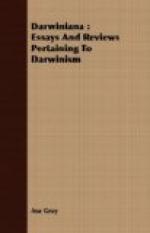use that he finds in a watch, this truth will go very
far toward proving, if it is not entirely conclusive,
that, in making it, the powers of life by which it
grew were directed by an intelligent, reasoning master.
Under the guidance of Paley he takes an eye, which,
although an optical, and not a mechanical instrument
like the watch, is as well adapted to testify to design.
He sees, first, that the eye is transparent when every
other part of the body is opaque. Was this the
result of a mere Epicurean or Lucretian “fortuitous
concourse” of living “atoms”?
He is not yet certain it might not be so. Next
he sees that it is spherical, and that this convex
form alone is capable of changing the direction of
the light which proceeds from a distant body, and of
collecting it so as to form a distinct image within
its globe. Next he sees at the exact place where
this image must be formed a curtain of nerve-work,
ready to receive and convey it, or excite from it,
in its own mysterious way, an idea of it in the mind.
Last of all, he comes to the crystalline lens.
Now, he has before learned that without this lens an
eye would by the aqueous and Vitreous humors alone
form an image upon the retina, but this image would
be indistinct from the light not being sufficiently
refracted, and likewise from having a colored fringe
round its edges. This last effect is attributable
to the refrangibility of light, that is, to some of
the colors being more refracted than others.
He likewise knows that more than a hundred years ago
Mr. Dollond having found out, after many experiments,
that some kinds of glass have the power of dispersing
light, for each degree of its refraction, much more
than other kinds, and that on the discovery of this
fact he contrived to make telescopes in which he passed
the light through two object-glasses successively,
one of which he made of crown and one of flint glass,
so ground and adapted to each other that the greater
dispersion produced by the substance of one should
be corrected by the smaller dispersion of the other.
This contrivance corrected entirely the colored images
which had rendered all previous telescopes very imperfect.
He finds in this invention all the elements of design,
as it appeared in the thought and action of a human
designer. First, conjecture of certain laws or
facts in optics. Then, experiment proving these
laws or facts. Then, the contrivance and formation
of an instrument by which those laws or facts must
produce a certain sought result.
Thus enlightened, our skeptic turns to his crystalline
lens to see if he can discover the work of a Dollond
in this. Here he finds that an eye, having a
crystalline lens placed between the humors, not only
refracts the light more than it would be refracted
by the humors alone, but that, in this combination
of humors and lens, the colors are as completely corrected
as in the combination of Dollond’s telescope.
Can it be that there was no design, no designer, directing
the powers of life in the formation of this wonderful
organ? Our skeptic is aware that, in the arts
of man, great aid has been, sometimes, given by chance,
that is, by the artist or workman observing some fortuitous
combination, form, or action, around him. He has
heard it said that the chance arrangement of two pairs
of spectacles, in the shop of a Dutch optician, gave
the direction




